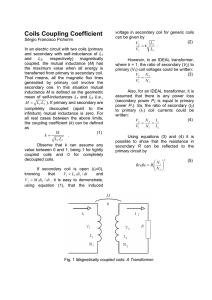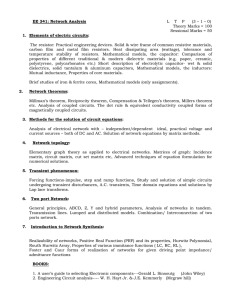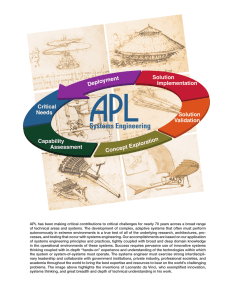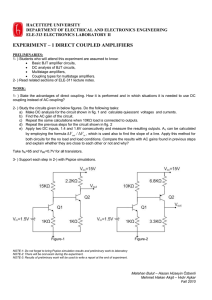Lect_12
advertisement
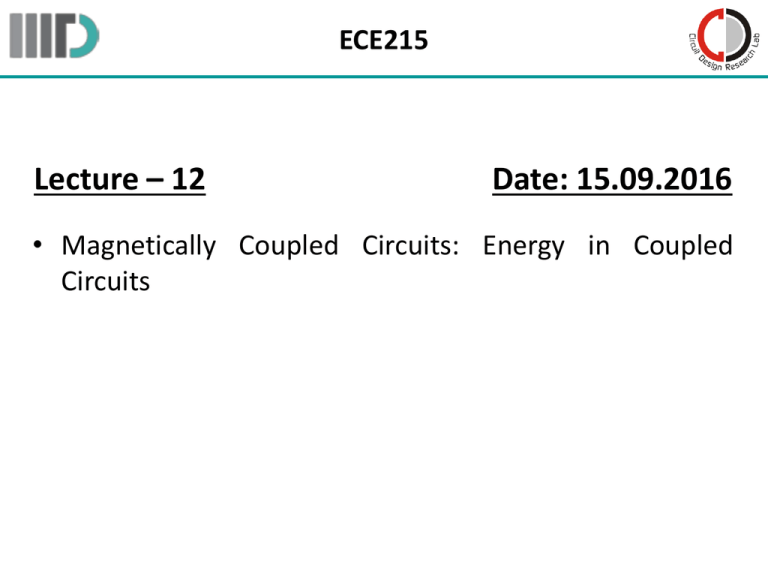
ECE215 Lecture – 12 Date: 15.09.2016 • Magnetically Coupled Circuits: Energy in Coupled Circuits ECE215 Example – 1 Calculate the total inductance. Example – 2 Two coils connected in series-aiding fashion have a total inductance of 250 mH. When connected in a series-opposing configuration, the coils have a total inductance of 150mH. If the inductance of one coil (L1) is three times the other, find L1, L2, and M. Example – 3 For the coupled coils, show that: ECE215 Mutual Inductance (contd.) Example • The KVL expressions in the frequency domain: • Another example: ECE215 Mutual Inductance (contd.) • Often, solving mutually coupled circuits requires tracking of two or more steps made at once regarding the sign and values of the mutually induced voltages. In this course, we are not concerned with the determination of the mutual inductances of the coils and their dot placements. We assume that the mutual inductance and the placement of the dots are the “givens’’ of the circuit problem, like the circuit components R, L, and C. ECE215 Example – 4 Calculate the mesh currents in this circuit. ECE215 Energy in Coupled Circuits • To find the stored energy as 𝑖1 = 𝐼1 and 𝑖2 = 𝐼2 : Step-1: 𝑖2 = 0 and 𝑖1 increases from 0 to 𝐼1 → the power in the circuit is the energy stored in the circuit Step-2: 𝑖1 = 𝐼1 and 𝑖2 increases from 0 to 𝐼2 → the power in the circuit is the energy stored in the circuit ECE215 Energy in Coupled Circuits (contd.) • The total energy stored in the coils when both and have reached constant 𝑖1 and 𝑖2 values is: Alternatively: ECE215 Energy in Coupled Circuits (contd.) • But the total energy stored should be the same regardless of how we reach the final conditions. • This equation is applicable when the currents both enter the dotted terminals or undotted terminals. ECE215 Energy in Coupled Circuits (contd.) In general: ECE215 Energy in Coupled Circuits (contd.) • The extent to which the mutual inductance M approaches the upper limit is specified by the coefficient of coupling k: The coupling coefficient is the fraction of the total flux emanating from one coil that links the other coil. ECE215 Energy in Coupled Circuits (contd.) If 𝑘 = 1, then we have 100 percent coupling, i.e., the entire flux produced by one coil links another coil: The coupling coefficient k is a measure of the magnetic coupling between two coils: 0 ≤ 𝑘 ≤ 1 ECE215 Energy in Coupled Circuits (contd.) • We expect k to depend on the closeness of the two coils, their core, their orientation, and their windings. The air-core transformers used in radio frequency circuits are loosely coupled, whereas ironcore transformers used in power systems are tightly coupled. 𝒌 < 𝟎. 𝟓 𝒌 > 𝟎. 𝟓 ECE215 Example – 5 Determine the coupling coefficient and calculate the energy stored in the coupled inductors at time 𝑡 = 1𝑠. Example – 6 Given, L1=40mH, L2=5mH, and coupling coefficient k=0.6. Find 𝑖1 (𝑡) and 𝑣2 𝑡 , given that 𝑣1 𝑡 = 10𝑐𝑜𝑠𝜔𝑡 and 𝑖2 𝑡 = 2𝑠𝑖𝑛𝜔𝑡, 𝑟𝑎𝑑 𝜔 = 2000 . 𝑠
